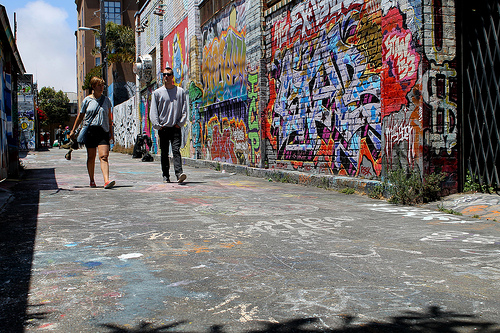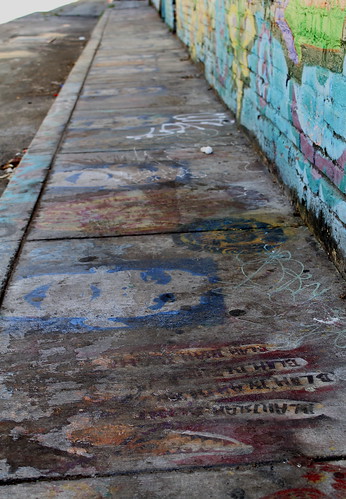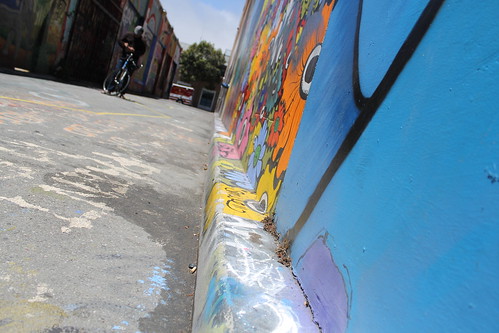(This post is brought to us by Lilly, Far Out City’s summer intern. Take it away, Lilly!)
Street art. A euphemism, some may say, for vandalism. For as long as man (or a mischievous high schooler with paint) has a wall, there shall be art. However San Francisco’s Mission neighborhood opens its arms invitingly to what society has stamped as a nuisance and must be removed and prevented.
Last month I got the opportunity to stay in San Francisco for a week. I’m from a relatively small town in Texas called New Braunfels. The last exciting thing to happen around these here parts was opening day of the worlds largest Buc-ee’s (consider it a gas station on steroids. It includes a whole wall devoted to jerky and holds eighty-three toilets.) Our town is also home to the world’s largest water park, Schlitterbahn. It’s German themed. Growing up, I firmly believed it was normal to see a sunbaked stranger floating down the river in an inner tube with a beer in one hand and a sausage-on-a-stick in the other. Living in the country there isn’t much in the way of street art other than the occasional vandalism done by the graduating seniors. So as a small town artist you can see the draw that the big city had on me.
How did this section of San Francisco become what it’s known for today? The Missions’ history of murals and art goes back to the 1930’s with the beginning of the Work’s Progress Administration, or WPA. The WPA was the original and beneficial government stimulus enacted by President Theodore Roosevelt as part of the New Deal. San Francisco received the second most WPA funding than any other city in the US (behind New York), thanks to the work of Mayor Angelo Rossi and his close ties with Washington. This funding contributed to many of landmarks that San Francisco is known for today, including the Golden Gate and Bay Bridges. Thousands of artist with a wide variety of specialties were put to work to beautify the city by showing local and national history through their work.
After experiencing a traumatic roller coaster earth quake in 1906, San Franciscans found themselves in search of solid ground again. The Mission was one of the least affected areas in the city, and people of all back grounds flocked to this neighborhood, creating a diverse mix of cultures. It’s only fitting that this mixed community would also have a rich and deep artistic community as well. You can find all styles of art here in the Mission, from the 1930’s art deco funded by the WPA, to the murals created by Mexican artists, and the modern street art movement inspired by other well known street artists like Banksy and Shepard Fairey. The art all reflects the history, politics, dreams, triumphs, and passion of their creators. Elsewhere, public artwork is considered a blight of the urban setting; however, in the Mission it’s embraced and praised. Every street, sidewalk, pole, wall, window, has art on it. It’s almost like walking through a coloring book.
The graffiti in my town is plain, drab, uncreative, and mostly messy indecipherable scribbles. Why is there such a difference? Why is street art so widely accepted in San Francisco but frowned upon in my home town?
Perhaps San Francisco’s history of extravagant funded art projects promoted early street art, and it builds on itself every year like a snow ball effect, causing each and every mural to push the limits on the last. Perhaps the city’s genetics played a role, since artists all around the country and world were invited here during the 30’s for the WPA.
Coming from an artist’s mind, I think it’s the allowance of freedom San Francisco gives its artists that leads to the high quality of art. San Francisco is on to something here by letting their residents’ artistry contribute to the overall loveliness of the city.












